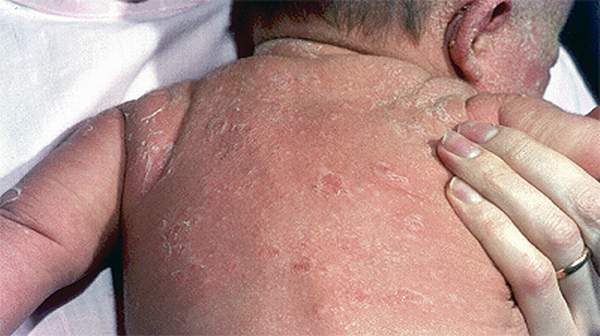What's in this article?
Definition
Scalded skin syndrome is a skin infection in which the skin becomes damaged and sheds.
Alternative Names
Ritter disease; Staphylococcal scalded skin syndrome (SSS)
Scalded skin syndrome: A potentially serious side effect of infection with the Staph (Staphylococcus) bacteria that produces a specific protein which loosens the “cement” holding the various layers of the skin together. This allows blister formation and sloughing of the top layer of skin. It is necessary to treat scalded skin syndrome with intravenous antibiotics and to protect the skin from allowing dehydration to occur if large areas peel off. The disease occurs predominantly in children under 5 years of age. It is known formally as Staphylococcal scalded skin syndrome and as Ritter disease.
Causes
Scalded skin syndrome is caused by infection with certain strains of Staphylococcus bacteria. The bacteria produce a poison that causes the skin damage. The damage creates blisters, as if the skin were scalded. These blisters can occur at areas of the skin away from the initial site.
Scalded skin syndrome is found most commonly in infants and children under the age of 5.
Symptoms
- Blisters
- Fever
- Large areas of skin peel or fall away (exfoliation or desquamation)
- Painful skin
- Redness of the skin (erythema), which spreads to cover most of the body
- Skin slips off with gentle pressure, leaving wet red areas (Nikolsky’s sign)
Who gets Scalded Skin Syndrome?
- Infants and young children generally below the age of 5 years are mostly affected by Scalded Skin Syndrome. Adults with kidney failure, immune system deficiency, and those undergoing chemotherapy are also prone to this bacterial infection
- No gender prevalence is observed when children are affected by SSSS; but when adults are affected, males are affected more than females
- A recent study reveals that Caucasians are more affected than other races
What are the Risk Factors for Scalded Skin Syndrome?
The risk factors for Scalded Skin Syndrome include:
- Children below age 5 years have the highest risk
- Adults suffering from kidney failure and poor/deficient immune system are also vulnerable
- Adults taking immunosuppressant drugs can easily contract this infection
- Adults undergoing chemotherapy also have a high risk of acquiring this infection
It is important to note that having a risk factor does not mean that one will get the condition. A risk factor increases ones chances of getting a condition compared to an individual without the risk factors. Some risk factors are more important than others.
Also, not having a risk factor does not mean that an individual will not get the condition. It is always important to discuss the effect of risk factors with your healthcare provider.
Treatment
Antibiotics are given through a vein (intravenously) to help fight the infection. Fluids are also given through a vein to prevent dehydration. Much of the body’s fluid is lost through open skin.
Moist compresses to the skin may improve comfort. You can apply a moisturizing ointment to keep the skin moist. Healing begins about 10 days after treatment.
What are the possible Complications of Scalded Skin Syndrome?
The complications due to Scalded Skin Syndrome may include:
- Dehydration: The management of fluid levels in the body may become a problem. When the fluid levels are not properly maintained, it can lead to dehydration and electrolyte imbalances
- Difficulties with temperature control, especially in infants
- Septicemia, when the entire bloodstream becomes infected
- Cellulitis: A medical condition characterized by deeper skin infection
- If the bacterial infection becomes severe and untreatable, it may lead to death.







